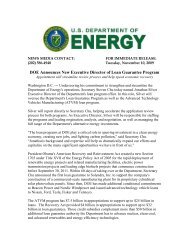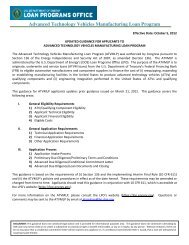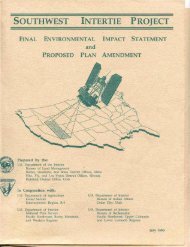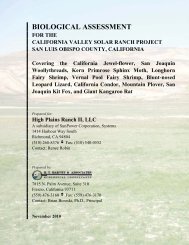Bureau of Land Management's Decision Record and Environmental
Bureau of Land Management's Decision Record and Environmental
Bureau of Land Management's Decision Record and Environmental
Create successful ePaper yourself
Turn your PDF publications into a flip-book with our unique Google optimized e-Paper software.
Jersey Valley Geothennal Development Project<br />
<strong>Environmental</strong> Assessment: NV063 -EAO8-09 1<br />
recorded within or near the Jersey Valley Unit Area <strong>and</strong> the proposed transmission line corridor<br />
(NNHP 2008a <strong>and</strong> 2008b). No threatened or endangered species were identified.<br />
Special Status Species<br />
The USFWS expressed concern that the proposed Project activities could potentially impact the<br />
greater sage grouse (Centrocercus urophasianus) <strong>and</strong> the pygmy rabbit (Brachylagus<br />
idahoensis).<br />
The NNHP identified (either within the proposed Project area or a 5 km buffer around the subject<br />
l<strong>and</strong>s): Lahontan beardtongue (Pensternon palmeri var. macranthus), windloving buckwheat<br />
(Eriogonum anemophilum) <strong>and</strong> Reese River phacelia (Phacelia glaberrima). Habitat may also be<br />
available for the Sadas pyrg (Pyrgulopsis sadai) <strong>and</strong> the Dixie Valley pyrg (Pyrgulopsis<br />
dixensis) (NNHP 2008a <strong>and</strong> 2008b).<br />
Additionally, the BLM MLFO requested surveys for burrowing owls <strong>and</strong> bats, <strong>and</strong> identified the<br />
ferruginous hawk (Buteo regalis), prairie falcon (Falco mexicanus) <strong>and</strong> golden eagle (Aquila<br />
chrysaetos) as potentially within or adjacent to the proposed Project Area.<br />
Greater Sage- Grouse<br />
Greater sage-grouse use sagebrush habitats with significant grass <strong>and</strong> forb components. Breeding<br />
habitat consists <strong>of</strong> habitat suitable for leks, nesting, <strong>and</strong> early brood-rearing areas. Suitable<br />
nesting <strong>and</strong> early brood rearing habitats are dominated by sagebrush with a healthy herbaceous<br />
understory. From late June to early November, sage-grouse will use a variety <strong>of</strong> moist <strong>and</strong> mesic<br />
habitats where succulent forbs are found. These habitats include riparian areas, wet meadows,<br />
lakebeds, farml<strong>and</strong>s, upl<strong>and</strong>s including sagebrush <strong>and</strong> recently burned areas. During the winter<br />
months sage-grouse feed almost exclusively on sagebrush. Sagebrush st<strong>and</strong>s with canopy covers<br />
<strong>of</strong> 10-30% <strong>and</strong> winter cover heights <strong>of</strong> at least 25 centimeters above the snow is needed.<br />
Topographic relief <strong>and</strong> a diversity <strong>of</strong> sagebrush heights in an area are important (Stamm 2006).<br />
All <strong>of</strong> the seasonal habitats for sage-grouse were either lacking within the surveyed portions <strong>of</strong><br />
the Jersey Valley Unit Area or were only present in marginal condition. No extensive st<strong>and</strong>s <strong>of</strong><br />
sagebrush were present <strong>and</strong> no signs <strong>of</strong> sage-grouse were observed (GBE 2008).<br />
The sagebrush within the transmission line corridor may occasionally serve as sage-grouse<br />
winter habitat for birds that normally spend the entire year in the Fish Creek Mountains or in the<br />
Tobin Range. In rare years when snow accumulation in these mountain areas is sufficiently deep<br />
to cover the sagebrush, sage-grouse may use the valley floor sagebrush (GBE 2008). Although<br />
some potential movement between the Fish Creek Mountains <strong>and</strong> the Tobin Range exists, data<br />
suggests this movement is seldom <strong>and</strong> unlikely. Based on radio telemetry data gathered from<br />
2003-04 in the Fish Creek Mountains, sage-grouse in the Fish Creeks appear to be nonmigratory,<br />
spending the entirety <strong>of</strong> the year in that range. In addition, no locations <strong>of</strong> individuals<br />
were recorded within 2 miles <strong>of</strong> any portion <strong>of</strong> the Project vicinity. Also, Great Basin Ecology<br />
- 45 -







